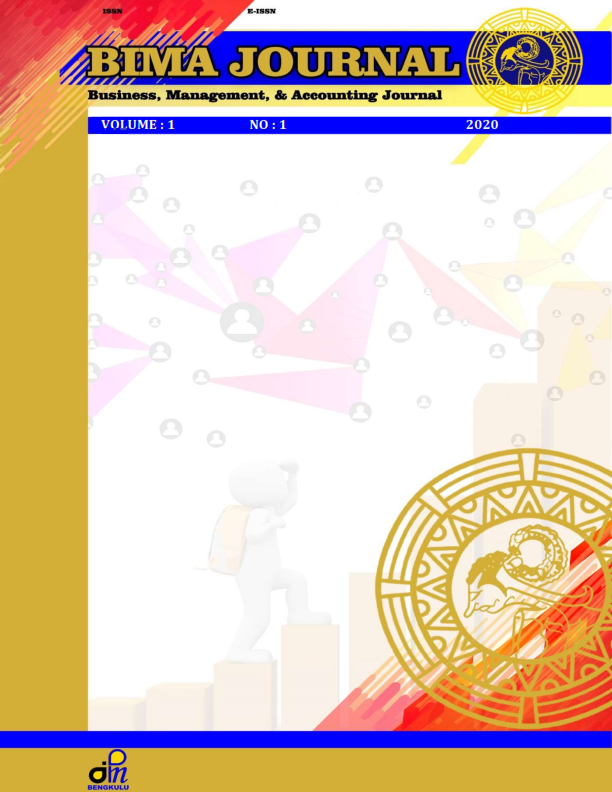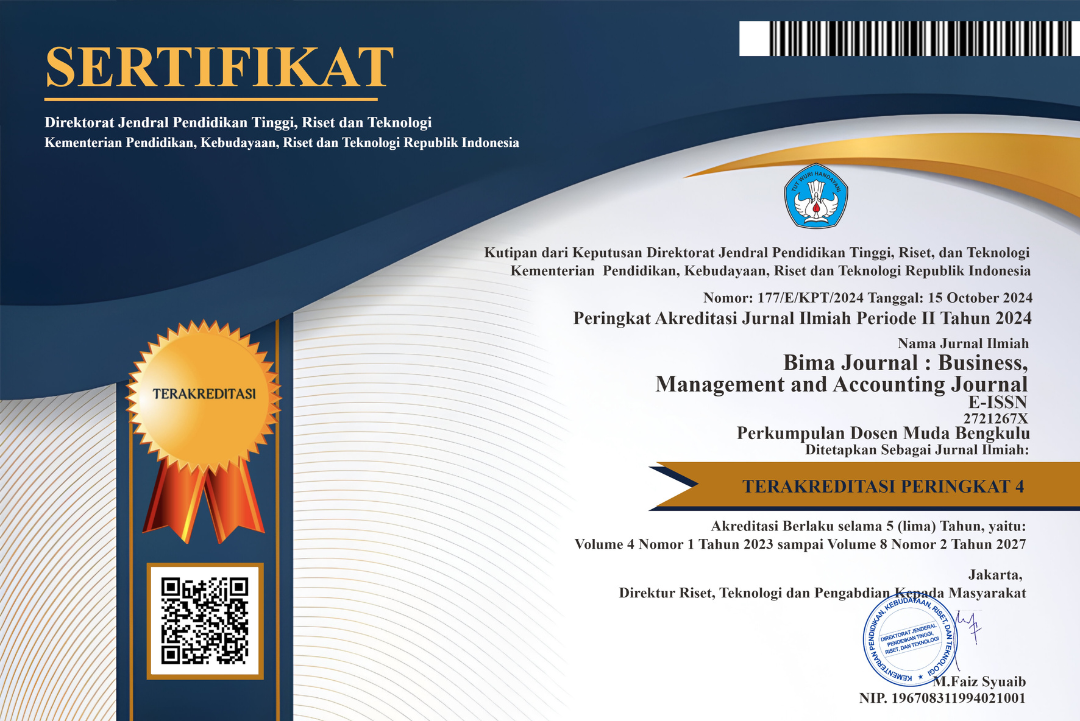THE EFFECT OF MUDHARABAH, MUSYARAKAH AND MURABAHAH FINANCE ON THE PROFITABILITY OF SHARIA GENERAL BANKS IN INDONESIA IN 2013-2017
DOI:
https://doi.org/10.37638/bima.1.1.49-60Abstract
This study aims to analyze the effect of mudharabah, musyarakah and murabahah financing on the level of profitability at Islamic Commercial Banks in Indonesia using the Return on Assets (ROA) ratio. The research method used is descriptive quantitative research approach and case studies at Islamic Commercial Banks in Indonesia. The type of data obtained from this research is secondary data based on the results of Sharia Commercial Bank financial reports which include BCA Syariah, BNI Syariah, BRI Syariah, Mandiri Syariah Bank, Syariah Bukopin and Muamalat Bank during the 2013-2017 period. Sources of data obtained through the results of publications from the relevant Islamic Commercial Bank and through the official website of each bank. The analytical tool used is multiple linear regression analysis.The results showed that Mudharabah and Mutanaqisah financing had a significant influence on ROA levels while financing for Murabahah had an insignificant effect on the partial ROA level. Simultaneously, this Mudharabah, Mutanaqisah and Murabahah financing has a significant influence on the level of ROAReferences
Amri Dziki Fadholi, (2015). Pengaruh pembiayaan Murabahah, Musyarakah, dan Mudharabah Terhadap Profitabilitas Bank Umum Syariah (Studi Empiris pada Bank Umum Syariah Di Indonesia Tahun 2011-2014). Jurnal Akuntansi. Universitas Muhammadiyah Surakarta.
Ascarya, (2011). Akad dan Produk Bank Syariah.Jakarta.PT Raja Grafindo Persada
Cut Faradilla, Muhammad Arfan, dan M.Shabri (2016). Pengaruh Pembiayaan Murabahah, Mudharabah dan Musyarakah Terhadap Profitabilitas Bank Umum Syariah di Indonesia. Jurnal MagiesterAkuntansi Universitas Syiah Kuala Banda Aceh.
Duwi Priyanto, (2011). Teknik Mudah Dan Cepat Melakukan Analisis Data Penelitian Dengan SPSS. Yogjakarta:Gava
Fadhila Novi (2015). Analisis Pembiayaan Mudharabah dan Murabahah terhadap Laba Bank Syariah Mandiri. Jurnal Riset Akuntansi dan Bisnis, Vol. 15 No. 1/Maret 2015.
Fatwa DSN-MUI No. 04/DSN-MUI/IV/2000
Fatwa DSN-MUI No. 07/ DSN-MUI/ IV/2000
Fatwa DSN-MUI No. 08/ DSN-MUI/ IV/2000
Hak Nurul (2011). Ekonomi Islam Hukum Bisnis Syari’ah. Yogyakarta: Teras.
Lukman Hakim (2012). “Prinsip-prinsip Ekonomi Syariah”. Yogyakarta: Erlangga.
Harahap, S.S, (2008). Analisis Kritis Atas Laporan Keuangan, Edisi Kedua. Jakarta: PT. Raja Grafind, Persada.
Irham Fahmi (2015). Manajemn Perbankan Konvnsional dan Syariah. Jakarta: Mitra Wacana Media.
Hanafi , M. dan A. Halim (2007). Analisis Laporan Keuangan, edisi ketiga. Yogyakarta: UPP Sekolah Tinggi Ilmu Manajemen YKPN.
Ikatan Akuntan Indonesia (2006). “Pernyataan Standar Akuntansi Keuangan No. 102 tentang Akuntansi murbahah”, Jakarta: Graha Akuntan.
Ikatan Akuntan Indonesia (2006). “Pernyataan Standar Akuntansi Keuangan No. 106 27 Juni 2006 tentang Akuntansi Musyarakah”, Jakarta: Graha Akuntan
Imam Ghozali (2013). Analisis Multivariate dengan Program IBM SPSS 21. Semarang : Badan Penerbit Fakultas Ekonomi Universitas Diponegoro.
Jayang Probo Pranata (2013). Pengaruh Pembiayaan Mudharabah dan Musyarakah Terhadap Profitabilitas Bank Umum Syariah (Pada Bank Umum Syariah di Indonesia tahun 2006-2011). Jurnal Akuntansi Sekolah Tinggi Ilmu Ekonomi Perbanas Surabaya.
Karim dan Adimarmawan A (2004). “Bank Islam: Analisis Fikih dan Keungan”, Jakarta; PT. Raja Grafindo Persada.
Kasmir dan Jakfar (2008). “Bank dan Lembaga Keuangan Lainnya” Edisi Revisi 2008, Jakarta: PT. Raja Grafindo Persada
Mujahidin Akhmad, 2016, Hukum Perbankan Syariah, Jakarta: PT Rajagrafindo Persada.
Nurul Hidayah (2017). Pengaruh Pembiayaan Murabahah, Musyarakah, dan Mudharabah Terhadap Tingkat Profitabiilitas Bank Umum Syariah Tahun 2012-2016. Jurnal Ilmu Ekonomi Pembangunan Universitas Surakarta.
Rivai, Veithzal, Dkk (2012). “Banking and Finance” Dari Teori Kepraktik Bank dan Keuangan Syariah Sebagai Solusi dan Bukan Alternatif Edisi Pertama, Yogyakarta: BPFE.
Rizal Yaya, Aji Erlangga, Ahim Abdurahim, (2014). Akuntansi Perbankan Syariah Edisi Kedua. Jakarta Selatan: Salemba.
Ahmad Rodoni & Herni Ali, (2014). Manajemen Keuangan Modern, Jakarta: Mitra Wacana Media.
Dheni Saputra Mahardika dkk, 2015. Analisis Risiko Pembiayaan Musyarakah terhadap Pengendalian Pembiayaan Nasabah. Jurnal Administrasi Bisnis (JAB),Vol. 28 No. 2 November 2015.
Soemitra dan Andri (2009). “Bank dan Lembaga Keuangan Syariah”, Jakarta: Prenada Media.
Sri Sundari, (2002). “Manajemen Keuangan” Edisi 3. Jakarta: Mitra Wacana.
Syamsudin, L (2007). Manajemen Keuangan Perusahaan, edisi baru, Jakarta; PT. Raja Grafindo. Undang-Undang Nomor 10 tahun 2008 Tentang Perbankan Syariah. Pemerintah Negara Republik Indonesia. Jakarta.
Undang-Undang Nomor 21 tahun 2008 Tentang Perbankan Syariah. Pemerintah Negara Republik Indonesia. Jakarta.
Warsono, (2008). Manajemen Keuangan Edisi Kedua. Yogyakarta: Ekonisia.
Wiroso, (2011). Akuntansi Transaksi Syariah. Ikatan Akuntansi Indonesia. Jakarta
Downloads
Additional Files
Published
Issue
Section
License
An author who publishes in the BIMA JOURNAL: Business, Management, and Accounting Journal agrees to the following terms:
Author retains the copyright and grants the journal the right of first publication of the work simultaneously licensed under the Creative Commons Attribution-ShareAlike 4.0 License that allows others to share the work with an acknowledgement of the work's authorship and initial publication in this journal
Submission of a manuscript implies that the submitted work has not been published before (except as part of a thesis or report, or abstract); that it is not under consideration for publication elsewhere; that its publication has been approved by all co-authors. If and when the manuscript is accepted for publication, the author(s) still hold the copyright and retain publishing rights without restrictions. For the new invention, authors are suggested to manage its patent before published. The license type is CC-BY-SA 4.0.
BIMA JOURNAL: Business, Management and Accounting is licensed under a Creative Commons Attribution-ShareAlike 4.0 International License.
You are free to:
Share — copy and redistribute the material in any medium or format
Adapt — remix, transform, and build upon the material
for any purpose, even commercially.
The licensor cannot revoke these freedoms as long as you follow the license terms.
Under the following terms:
Attribution — You must give appropriate credit, provide a link to the license, and indicate if changes were made. You may do so in any reasonable manner, but not in any way that suggests the licensor endorses you or your use.
ShareAlike — If you remix, transform, or build upon the material, you must distribute your contributions under the same license as the original.
- No additional restrictions — You may not apply legal terms or technological measures that legally restrict others from doing anything the license permits.
Notices:
- You do not have to comply with the license for elements of the material in the public domain or where your use is permitted by an applicable exception or limitation.
- No warranties are given. The license may not give you all of the permissions necessary for your intended use. For example, other rights such as publicity, privacy, or moral rights may limit how you use the material.





















